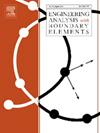基于物理信息的神经网络在利率和波动率耦合金融定量系统中的障碍期权定价
IF 4.1
2区 工程技术
Q1 ENGINEERING, MULTIDISCIPLINARY
Engineering Analysis with Boundary Elements
Pub Date : 2025-10-07
DOI:10.1016/j.enganabound.2025.106457
引用次数: 0
摘要
障碍期权的准确定价对于促进明智的投资决策、优化资源配置和促进市场稳定至关重要。利率和波动率的动态变化对障碍期权定价有显著影响。与常数参数相关的传统方程可能无法捕捉这些复杂性。本文假设标的资产遵循包含可变利率和波动率的扩展几何布朗运动,然后基于Kolmogorov前向方程和后向方程推导出看涨期权和卖出期权的耦合定价系统,从而实现对波动率波动的分析。较高的波动性表明较高的风险水平,这可能对应较高的潜在回报。引入融合框架,即物理通知神经网络(PINN)来解决这个耦合系统,该系统由两个子网组成:一个用于估计障碍期权价格的期望值,另一个用于捕获与期权价格相关的波动面。基于沪深300ETF期权收盘价数据的实验结果表明,PINN为金融衍生品价格评估提供了一个有效、高效的框架,即使在无法获得封闭形式分析解的情况下,也具有较高的精度和可解释性。本文章由计算机程序翻译,如有差异,请以英文原文为准。
Physics-informed neural network for barrier option pricing in coupled financial quantitative system with varying interest rate and volatility
Accurate pricing of barrier options is essential for facilitating informed investment decisions, optimizing resource allocation, and promoting market stability. The dynamics of interest rate and volatility significantly influence the barrier option pricing. Traditional equations associated with constant parameters may fail to capture these complexities. In this paper, the underlying asset is assumed to follow an extended geometric Brownian motion incorporating varying interest rate and volatility, and then a coupled pricing system for the up-and-out call option is derived based on the Kolmogorov forward equation and backward equation, enabling the analysis of volatility fluctuations. Higher volatility indicates a greater level of risk, which may correspond to higher potential returns. The fusion framework, the physics-informed neural network (PINN), is introduced to solve this coupled system, consisting of two subnetworks: one dedicated to estimating the expected values of barrier option prices, and another for capturing the volatility surface associated with the option prices. Experimental results based on the closing price data of CSI 300ETF options show that PINN offers an effective and efficient framework for evaluating the prices of financial derivatives, achieving high precision and interpretability, even in cases where closed-form analytical solutions are unavailable.
求助全文
通过发布文献求助,成功后即可免费获取论文全文。
去求助
来源期刊

Engineering Analysis with Boundary Elements
工程技术-工程:综合
CiteScore
5.50
自引率
18.20%
发文量
368
审稿时长
56 days
期刊介绍:
This journal is specifically dedicated to the dissemination of the latest developments of new engineering analysis techniques using boundary elements and other mesh reduction methods.
Boundary element (BEM) and mesh reduction methods (MRM) are very active areas of research with the techniques being applied to solve increasingly complex problems. The journal stresses the importance of these applications as well as their computational aspects, reliability and robustness.
The main criteria for publication will be the originality of the work being reported, its potential usefulness and applications of the methods to new fields.
In addition to regular issues, the journal publishes a series of special issues dealing with specific areas of current research.
The journal has, for many years, provided a channel of communication between academics and industrial researchers working in mesh reduction methods
Fields Covered:
• Boundary Element Methods (BEM)
• Mesh Reduction Methods (MRM)
• Meshless Methods
• Integral Equations
• Applications of BEM/MRM in Engineering
• Numerical Methods related to BEM/MRM
• Computational Techniques
• Combination of Different Methods
• Advanced Formulations.
 求助内容:
求助内容: 应助结果提醒方式:
应助结果提醒方式:


